The John Stewart Collection—Shelf Two
|
The John Stewart Collection—Shelf Two |
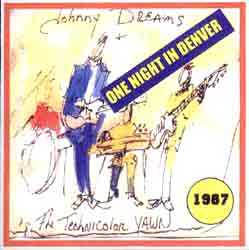
(Image from the cover of the One Night
in Denver CD)
[Art by John Stewart]
Years of Long Letters from a
Good Friend
(1980-1990)
Some folks wonder if John Stewart doesn't have periods of prescience. Some of the songs on Dream Babies Go Hollywood seemed to imply that he sensed a shift coming, "Lady of Fame" in particular.
We have heard that after that album, while Stewart was at the pinnacle of success, eleven years after California Bloodlines, RSO records went bankrupt under him. What followed was unlike anything we would see for a lot of years.
There was a story in the papers a few years ago about Tiger Woods. If we recall it correctly, it went to some lengths to point out that Tiger was doing something unprecedented. After a season or three when he basically rewrote the record books in professional golf, he stepped back at the end of the season and found himself unsatisfied with his game. He had come farther, faster, bigger and stronger than any other person in his profession's history—and he wasn't satisfied with the tools that had gotten him there! So he totally dismantled his game. He broke the sleek, supercharged rocket of his craft down into its component parts and started over—grip, stance, stroke, equipment, approach—from basics, and tinkered with everything before rebuilding—somehow improving on near-perfection.
We don't know what happened with John Stewart after the 1980 release of Dream Babies Go Hollywood. We can only look from the outside and come to our own conclusions. From here, then, it looks like he beat Tiger Woods to the punch by almost 20 years. And the amazing thing is that he put a huge piece of the process out in public view so his fans could share in his pursuit of an even-higher standard. Honesty, trust and total lack of false pride rarely come any bigger than what was about to occur.
He went back to his roots—and put out a 7-song LP with his old partner from the Kingston Trio— Nick Reynolds—and blended in a bunch of friends shown standing around an old shack on the back of the LP, like Lindsey Buckingham, Linda Ronstadt and others.
He went back to the musical foundations of his sound—and put out a purely instrumental album, on which he played every note on every instrument. And it wasn't just any instrumental album. He crossed his guitar with Aaron Copland, and put in his vision of history and America, and wrote a suite that we'd love to hear sometime by a really fine chamber orchestra. Not because it needs it, but because it would be fun, and might go a small way toward giving him his due.
He rebuilt his accompanying sound, playing sessions and sitting in with others—and put out Blondes with Chuck McDermott. As time went by, he added players to his "backing band," bringing them into and flexing his music to their skills. More than twenty years later, Dave Batti and Dennis Kenmore and others are still there with him.
One must assume that times cannot be financially easy for an artist without a major label—but he reached all the way back to Signals Through the Glass (and into what must have been an unbelievable first-hand tragedy), recast almost 15 songs for The Last Campaign—and donated royalties to the RFK Memorial Fund.
He returned to the songs and memories from his time with the Kingston Trio (and his friendship with Nick Reynolds)—and put out The Trio Years, a collection of the songs he had written and recorded 20 years earlier, re-arranged and done up fresh, informed by the skills and perspective hard-won in the interim, and featuring the full-grown sound of the band that was building behind him.
He recorded and published an album of new material (Trancas) on a small label—almost as if he was making sure that his lyrical skills stayed sharp. Some of his fans wouldn't find this record until many years later. It contains some of his most beautiful and haunting songs ever, and marked a new direction in his craft that couldn't really be appreciated by outsiders without the benefit of hindsight.
And the most amazing thing of all—he showed his fans his creative process. He took the biggest risk we can imagine for a creative artist. He issued "albums" on cassette tape only, that he had built in his home, on an 8-track, quarter-inch tape recorder. (They are breathtaking and beautiful and superior to the vast majority of the recording work that was being issued by the major labels.) It is as if he said, "Here's some ideas I'm looking at, and some directions I'm considering—some rough drafts and sketches, if you will. I'm going to let you look at these in their unpolished state, and judge me and my art, even though it hasn't been pushed through a full production process—and trust you enough to take any lumps and build in the feedback, because both you and my craft are that important to me."
After seven years of this, he went into the studio and came out with an album that marked one of the most neglected high-water marks in the history of American music—Punch the Big Guy. And, apparently never slackened at all for the next three years—continuing to share new material with his fans through cassettes of his home-made recordings—he built an even higher peak that resulted in the live recording Neon Beach. There is more to say, in the comments to that record, but, by any standard, Neon Beach is a modern classic in every sense of the word. And once again, he gave it to us just when we needed it.
Please come share this process...
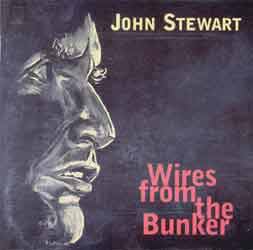 Wires
From the Bunker
Wires
From the Bunker
Unreleased recordings from (roughly)
1981-1983
2000 release on Appleseed (US) and Wrasse (UK) Records CD
Produced by John Stewart
(Cover image is from the CD insert)
Cover art painted by Gillian Walker
This album has one of the most delightful "back stories" in the history of modern music. Only Tom De Lisle, a friend of John Stewart for over 25 years, and the premier writer on all-things-Stewart, can properly tell it. (The following is excerpted from the liner notes in the CD insert. For the whole story, order the album, ok?)
"...(John) called me in December of 1991... 'Hey,' said he, 'I found an old box of tapes that I've had around for years. I was gonna throw them out, but then I thought you might want them. If you don't, I'll just toss them, I'd just as soon get rid of 'em.' Don't throw them away! I carefully repeated my address here in Mt. Clemens, Michigan, outside Detroit, to John over the phone. He promised to send them on the cheap via a UPS truck within the next few days. 'Are you sure...?'
Don't throw them away. Knowing John, and his disregard for his work, I figured there was a 50-50 chance I'd ever see those recordings. About two weeks later, on an icy, blowing, and frigid day here in Mt. Clemens, came a knock on my door. I beheld a UPS man on my front porch, straining under the load of a huge and dilapidated cardboard box, bound together around the top and bottom by the cheapest of masking tape. The binding wasn't working—cassette tapes were protruding from the bottom, and the guy was trying to keep them in with his knee. I could only see his hat. 'Do you want this?' he asked sarcastically from behind the overflowing two by three foot monstrosity. Did I ever.
Get this, it's the stuff of Freudian analysis: my street address has five digits. The address scribbled on the side of the box has SIX digits, two of them out of left field. And the damn zip code was incorrect... And how the hey the box, which was now The Box That Ate Mt. Clemens, ever got here is testimony to the work of music-loving guardian angels..."
Provident angels... John Stewart himself has called Tom De Lisle "the keeper of the flame." Thanks to his curatorship of "TBTAMC," a steady trickle of releases has issued from the famous box. One can argue that this collection is the most significant to date. There are stories that included in these cuts is an unreleased album from about 1980, that would have been called ____________________ . There are appearances on some of the songs by Dave and Katherine Guard and Nick Reynolds from the Kingston Trio days, Henry Diltz, Michael Stewart, Lindsey Buckingham and others.
The disk itself is amazingly insidious. Once it got slotted into the right place in our mental hardware, the songs kept sneaking into our consciousness without warning. If you have decided at some point that you have become a fan of this man, you absolutely have to own this!
With that said, it must be admitted that the slotting process took a little while, so some hints are offered. The first playing of this album was out of any context and we didn't "get it." So it sat for a while, and then was played in its time context, after the RSO issues—same thing. Then one day it came up, at random, after Sunstorm in the CD changer. KAZZOTTT!!! Nailed! Now it won't go away.
The songs:
1. American Way
2. Under Heavy Fire
3. Same Old Heart
4. When the Night Was Ours
5. Hot on the Trail
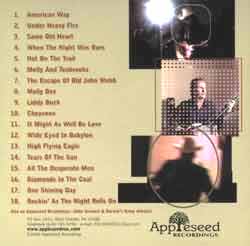 (Image
is from the back of the CD insert)
(Image
is from the back of the CD insert)
6. Molly and the Tenbrooks
7. The Escape of Old John Webb
8. Molly Dee
9. Liddy Buck
10. Cheyenne
11. It Might as Well Be Love
12. Wide Eyed in Babylon
13. High Flying Eagle
14. Tears of the Sun
15. All the Desperate Men
16. Diamonds in the Coal
17. One Shining Day
18. Rockin' as the Night Rolls On
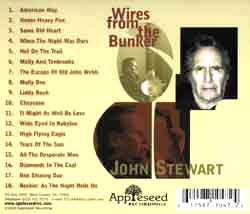
(The image is from the backplate of the CD )
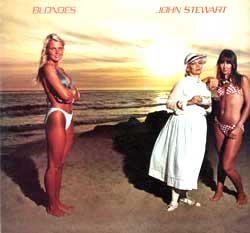 Blondes
Blondes
1982 Allegiance Records release on
LP
Produced by John Stewart
(Cover image is from the LP)
Photography by Kim Harwood
Newly re-issued with the additional
cuts from the Swedish LP release.
And the world had gone nuts.
In the two or three years since the Dream Babies albums, we had gone through 444 days of embassy hostages in Iran, and a war between Iran and Iraq that featured defenseless children being marched through minefields to clear lanes for the assault troops behind them. There were assassination attempts on the President and the Pope, the killing of John Lennon, double-digit inflation, gas shortages and the loss of John Belushi. Somewhere in there, if memory serves, the National Museum of American History even managed to lose George Washington's dentures.
Robert Palmer was "looking for clues" (along with the rest of us) and working on things that would lead to "Simply Irresistible" a few years later and a video archetype of the '80s, with John Stewart's mannequin multiplied and made over in black instead of blonde.
The IBM PC was one year old.
How in the world could a man who would later describe himself as sometimes being as much "reporter" as "songwriter"—an artist who works in tone and nuance, harmony and rhythm—hope to deal with the discordance and atonalities that were coming at us from all sides? And he is so clearly a citizen of the world there wouldn't have been any way to avoid it.
All these years later, we know a little part of the answer, thanks to Tom DeLisle and TBTAMC, and songs like "Under Heavy Fire" and "Tears of the Sun" from Wires from the Bunker, recorded during this period and lost in the cardboard for nearly twenty years. Part of the answer would appear on Centennial, part on Trancas, and huge piece called "Dreamers on the Rise" on Revenge of the Budgie. Part of the answer is, undoubtedly, here.
Some of us aren't sure we have ever gotten this album properly into perspective. It was as if Stewart did nearly an entire album of the "woman at the window/woman by the road" songs that had been threaded through all his previous albums. We had learned to look to the album art for some of the answers to our questions, but this one has always been hard to figure out. The music was great, and there were at least two songs that would have to be included on any "Greatest Hits" package (actually three others would be included on the 1999 Wrasse compilation, but they left out "The Eyes of Sweet Virginia" and "Blonde Star"). Still, it was as if we were missing something...
America's land holds the braided wisdom from many cultures. One of the quieter strands, taught to some of us near the buttes and coulees on the Northern Plains, holds that all babies are perfect gifts from the creator. Women carry that perfection into adulthood but can fall to mistakes. Men are destined to grow into the flaws they have been given, and it is their job to figure it out and try to fix it during their time. Ordinary mortals are not given to understand the mysteries and puzzles that surround them until their time is up, and the old woman who sits at the southern end of the path of souls we call the Milky Way looks back at their ways.
There have been a lot of mornings around here when these whispers from the land and water ring very true. We don't know if they have spoken to John Stewart, but one can tell from his songs that he hears some very old voices, and he did dedicate "Spirit" to John G. Neihardt in 1973...
All of which makes it a little less than surprising that an artist this sensitive to things in the wind would devote most of an album to looking for wisdom in the ways of women and the patterns in the windows and along the roads, as the world around us made less and less sense.
Listen to "The Eyes of Sweet Virginia" and tell us how wrong we are.
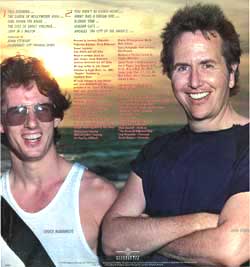 (Image
is from the back of the original album)
(Image
is from the back of the original album)
The songs:
Side One
1. Tall Blondes
2. The Queen of Hollywood High
3. Girl Down the River
4. The Eyes of Sweet Virginia
5. Judy in G Major
Side Two
6. You Won't Be Going Home
7. Jenny Was a Dream Girl
8. Blonde Star
9. Golden Gate
10. Angeles (The City of the Angels)
 (Image
is from the cover of the 2003 Neon Dreams CD combined re-release.)
(Image
is from the cover of the 2003 Neon Dreams CD combined re-release.)
Additional cuts on the new reissue from the Swedish
LP release in 1982
11. All the Desperate Men
12. Same Old Heart
13. When the Night Was Ours
The original LP issue of Blondes is out-of-print in both the US and Swedish release formats. The US release was re-issued as an import, but has been very hard to find. Neon Dreamsre-released all the tracks from both versions, in the version long requested by fans and this has also gone out-of-print.
Reveng of the Budgie
1983 Takoma Records release on
LP
Produced by The Puppy Brothers
(Cover image is from the LP)
Photography by Henry Diltz
It may be folk music on steroids, but that's what it is. It had been (according to Lindsey Buckingham's liner notes) 16 years since John Stewart and Nick Reynolds had collaborated. All the way back to the "second" Kingston Trio... We've heard that at about this time, Brother Stewart had put together something called "The World's Loudest Folk Band" and was playing clubs up and down the California coast. Some of that has to be reflected here. The opening cut has a huge sound, for instance.
But the reason that a lot of us love this album of just seven tracks is that it is unapologetically folk—not "post-folk" or "modern" folk or "neo-" folk. Folk music!
So how do we know this? It is joyful. There was a time (for those among you who are younger than dirt) when a lot of people would drive for hours to sit in an auditorium full of strangers and actually listen to two or three or four people play acoustic instruments and sing in pure and creative harmony. (All right—Peter, Paul and Mary kinda sang in the cracks between the piano keys, but that's another story.) Yes, there were delicate and nuanced voices and melodies. But you knew you were at the real thing when everybody said to heck with decorum and delicacy and reached down and grabbed their voice from the bottom and let it all out... Part of the essence of the folk music experience was realizing that people had cut loose all that vocal restraint drilled into them in choirs, gone all the way out to shout-mode, and then pulled it back just enough to have a little control.
And it wasn't just the performers on stage. Sure, you went to listen. But you also knew that you were going to sing along part of the time, and you were going to let your own vocal instrument out, however rusty and ill-tuned, and let it play—joyfully. You'd drive— sometimes through blizzards for Pete's sake, when sensible people were home digging out extra blankets and putting some of them in the dog's house—through hours of anticipation. And you'd drive home in glee and people interrupting each other...
In between the going there and the coming back, something bigger than the assembled parts would have happened. There were moments that were electrifying. There were moments when the hair stood up on the back of your neck and you could feel something huge and invisible had come into the place. Without meaning any disrespect to any side of the comparison, it can be said that the only comparable experiences for some of us have happened as visitors to Pentecostal churches and high, quiet places...
And the instruments were given their own place and voice. Guitars and basses and banjoes weren't there to be a backdrop to the vocals. They were an integral part of a seamless and sometimes seamy whole that pulled energy out of the air and the audience and fed it back and multiplied it and pulled you in and made you feel loved, by Godfrey. You didn't just listen to this music, even on a record player. You participated. Joyfully.
So that's how we know that this album is folk music. These people are having FUN! We'll swear that if you listen closely you'll hear an involuntary "wow" and a sort of proto-"yahoo" hidden back in there somewhere, that tell you that the big invisible something had come into the studio through the fire door and kicked somebody in the pants.
Nowadays, in some circles, it is very cool to say that some folk folks were just too effete about things in general. To heck with cool! The real stuff was hot. And it didn't matter if it was the Limelighters, or the Chad Mitchell Trio, or Odetta, or the Journeymen, or the Kingston Trio, or too many other groups and individuals to possibly name here—those auditoriums were no place for snobs. Real community magic isn't for snobs.
Sometimes it has to be silly. Face it. Too much serious is a drag. You want a little fun? Listen to the last cut. Although we don't know, and can't tell from the credits, we're pretty sure that's John doing a Johnny Cash vocal tribute and it might just be him singing above his normal range at the same time, through the wonders of studio magic. You want serious? Listen to the words. Do you sometimes need permission to put your thumb out, by life's freeway? Spend some time with "Hiding in the Shadows."
And if you're looking for an anthem for the half-generation that came right before the "Baby Boomers"—the people who have been characterized as being identifiable by their constant use of the phrase "on the other hand"—play "Dreamers on the Rise..." Repeatedly. And if the light is right, and the news is off, and you've left the heavy parts of your world out in the yard, then that great unseen something may just sneak into the room and hug you so hard that tears come to your eyes...and tell you that you are never alone.
Now that's music. This album brings it back in a whole new, old way. Voices ringing...strings singing...and that great invisible something that loves us keeping time and humming along... You will find yourself coming back to this album years later. And you'll always find something new...and very old.
A friend of ours in Wisconsin says that this big sound is the "yin" of folk music, and points ahead a few years to An American Folk Song Anthology as the more traditional, quieter "yang." Works for us...
The songs:
Side One
1. Buddy Won't You Roll Down the Line
2. Dreamers on the Rise
3. Cheyenne
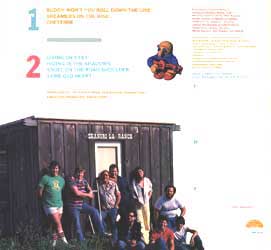 (Image
is from the back of the original album)
(Image
is from the back of the original album)
Side Two
4. Living on Easy
5. Hiding in the Shadows
6. Angel on the Road Shoulder
7. Same Old Heart
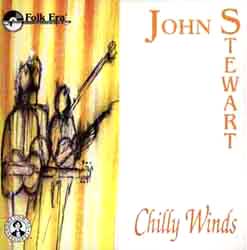
(The image is from the cover of the CD re-issue)
The original issue of Revenge of the Budgie is out-of-print. It was re-issued as the last seven songs on the Neon Dreams CD Chilly Winds, which has now gone out-of-print.
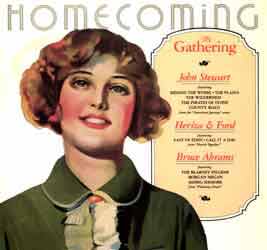 The
Gathering
The
Gathering
1984 Homecoming Records release on
LP
Produced by John Stewart
(Cover image is from the LP)
Design by Tommy Steele/Steele Works
After Blondes was issued, John Stewart formed his own publishing company—Homecoming Records. This was the first issue. It included instrumental work that would make up part of a separate recording in the "American Journey" series called Centennial. It also included selections from the Heriza and Ford album Hearts Together and the Bruce Abrams E. P., Delancey Street.
Once again, he surprised us. While we had been thinking of him as a vocalist, he was recording every instrumental part for a non-vocal album. While we had been thinking of him as a poet who wove a little country, folk and plain old rock and roll into his songs, he was listening to Aaron Copland and thinking so far out ahead of us that he was in a different landscape altogether. While we had been listening to him on Top-40, and waiting for the next combination with Lindsey Buckingham and Stevie Nicks and Linda Ronstadt, he had made a leap forward of incredible dimensions.
The songs:
[Titles in blue type are by John Stewart.
Titles
in dark red are by others, including Buffy Ford Stewart.]
Side One
1. Behind the Wheel
[The Plains]
2. Distant Wagons
3. Wichita Cross Winds
4. East of Eden (Cathy Heriza and Buffy Ford Stewart)
5. Call it a Day (Cathy Heriza and Buffy Ford Stewart)
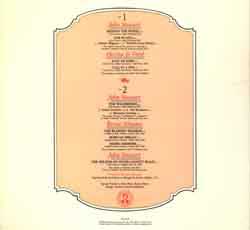 (Image
is from the back of the original album)
(Image
is from the back of the original album)
Side Two
[The Wilderness]
6. Indian Summer
7. The Hooliann
8. Montana Crossing
9. The Blarney Pilgrim (Bruce Abrams)
10. Morgan Megan (Bruce Abrams)
11. Shibig Shimore (Bruce Abrams)
12. The Pirates of Stone County Road
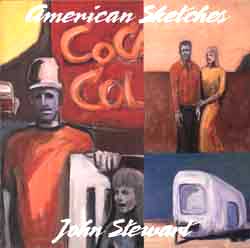 (The
image is from the cover of the CD re-issue)
(The
image is from the cover of the CD re-issue)
The John Stewart selections were re-issued on CD as a portion of American Sketches, which has now gone out of print.
 Trancas
Trancas
1984 Affordable Dreams release on
LP
Produced by John Stewart
(Cover image is from the cover of the original LP)
Four years after RSO Records went toes up on him, after the joyous reunion with Nick Reynolds and Lindsey Buckingham, et al, for Revenge of the Budgie, and the incredible achievement of the solo instrumental album that would be called Centennial, he put out an absolutely amazing album called Trancas. Except for a few die-hard fans and lucky cutout bin aficionados it didn't get a lot of notice. Darn shame, that.When the rest of us found it, later, we flipped the jacket over to see who was playing on it. It was an extremely short list. John Stewart. That's it. "Performed by John Stewart." Nobody else... Since it was a habit by then to have the album on for the first time while we read the liner notes and album credits, and we were listening to a fully-realized instrumental backing, that gave us a little pause. We didn't know what was to follow...we had no idea just how much was going to be quietly shared by this artist in the next few years. Our order for The Secret Tapes still hadn't come in, for one thing.
It would have been understandable if the first solo album after the good ship RSO slid under had had a little bit of bitter here and there. Not our friend. The subject was addressed, all right. It had been five years since Bombs Away Dream Babies, and the "popular" culture now knew him as, "oh, yeh—the guy who sang Gold, right?" Listen to the first cut, "It ain't the gold, that keeps you on the highway in the cold. It ain't the gold, that keeps your wheels a-turning when you're old. It's not the end, it's the beginning..." Wow!
And then he proceeded to lay down track after track that not only showed that he still had all his chops, he was getting better! The good part about the whole thing was that when a lot of us finally stumbled on it later, it was like finding something priceless (and timeless) in an old trunk in the attic. Over the years since, this has been a favorite for taking a friend who had just been introduced to Mr. Stewart to the next step in fandom. Because this neglected treasure has some of the finest songs written during the decade that it was released, and at least one that is among the very best he has ever written, in at least a few not-very-humble opinions.
There are so few truly class acts in this world...
The songs:
Side One
1. It Ain't the Gold
2. Reasons to Rise
3. Pilots in Blue
4. Chasing Down the Rain
5. 'Till the Lights Come Home
Side Two
6. Bringing Down the Moon
7. All the Lights
8. Rocky Top
9. The American Way
10. The Chosen
(Added on the CD reissue edition)
11. The Heart of a Kid
12. Irresistible Targets
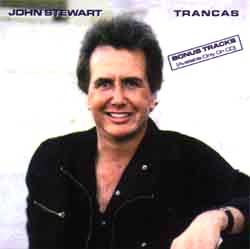 (The
image is from the cover of the CD re-issue)
(The
image is from the cover of the CD re-issue)
The original issue of Trancas
is out-of-print. It was re-issued in CD format, but has now gone out-of-print.
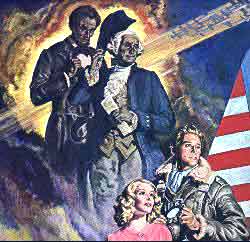 Centennial
Centennial
1984 Homecoming Records release on
LP
Produced by John Stewart
(Cover image is from the LP)
Centennial was the full version of the one-man instrumental, Copland-esque masterpiece that John Stewart had introduced in The Gathering.By the time it was re-issued as American Sketches, he had even done the art on the CD insert. As the artist himself said, in the liner notes he also wrote, "Playing all the instruments on an album is its own kind of madness. It's like doing a painting though, all the ideas are mine. Doing an album with a band is like doing a movie. If you ever get a chance to drive through the American West, may I suggest American Sketches as the sound track."
Those of us who have done just that agree with this one as a soundtrack. It also works very well as a background when you are really concentrating on something tough and complicated.
And one sharp morning it was the perfect background to some of the prettiest country God ever made, heading west through the mountains of West Virginia, somewhere between the sea and the bluegrass waves. It works pretty good in the American East, too.
The songs:
[The Plains]
1. Distant Wagons
2. Wichita Cross Winds
3. Betsy from Pike
4. Indian Springs
[The Wilderness]
5. Grand Canyon Summer
6. The Hoolian
7. Montana Crossing
8. After the Rain
9. The Launch of Apollo 11
10. Behind the Wheel
11. The Gold Rush

(The image is from the cover of the CD re-issue)
The original issue of Centennial is out-of-print. It was re-issued in CD format as American Sketches, which has now gone out of print.
 The
Last Campaign
The
Last Campaign
1985 Homecoming Records release on
LP
Produced by John Stewart
(Cover image is from the LP)
Photography by John Stewart
"I first met Robert Kennedy when he was Attorney General and I was a member of the Kingston Trio. We stayed in contact over the years and I was proud to be one of those who campaigned with him when he ran for President in 1968. Buffy and I traveled with the campaign and sang on the backs of trains, flat-bed trucks, town squares and high school auditoriums. I wrote songs as we went and the images of the people who loved him and believed in what he told them has been the inspiration for other songs, years after it was over..."
Second, it is the brave act of a selfless person. A royalty from every album was, and is, paid to the RFK memorial fund.
Next, this is not repackaged material. The songs were thought about and recast and redone, with new people in the band and new voices aboard. It features Linda Ronstadt and Lindsey Buckingham and others. But one of the things that we love best about it is that this is the first recording of which we are aware that has Dave Batti and Dennis Kenmore credited. These were the guys (along with Chuck McDermott) that John Stewart began sitting in with, and inviting over to his house to play, during the strange interregnum after RSO imploded. They were still there five years after this album, on a September night when the pool game of life gave them all a 9 off the break. And they are still there now, almost twenty years after this album. Talk about quality calling to quality...
John Stewart's fans know these songs. There are two new ones out of the ten. But even fans who have passed it by, because of that, might just be surprised. It is entirely possible that you will find that the definitive version of one you know well was pressed into this vinyl. There is at least one where we're pretty darn sure of it. And we're real sure that we are going to hear about those remarks...
The songs:
Side One
1. Clack Clack / Oldest Living Son
2. You Can't Go Back to Kansas
3. The Pirates of Stone County Road
4. Dreamers on the Rise
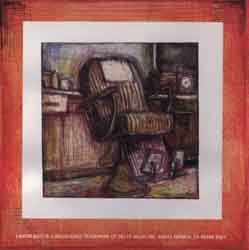 (Image
is from the back of the CD re-release.)
(Image
is from the back of the CD re-release.)
Side Two
6. Cody
7. Spirit / Survivors Medley
8. Hearts and Dreams on the Line
9. Crying in the Storm
10. Last Campaign (Reprise)
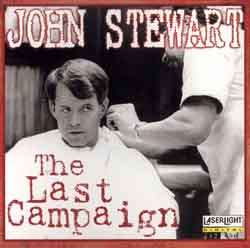 (The
image is from the cover of the CD re-issue)
(The
image is from the cover of the CD re-issue)
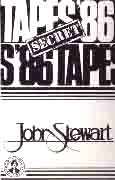 The
Secret Tapes '86
The
Secret Tapes '86
1986 Homecoming Records release on cassette
Produced by John Stewart
(Cover image is from the cassette sleeve)
And then there's this buried masterpiece.It had been a while since Blondes and The Gathering. Trancas had slipped by a lot of us, unseen. But it sure felt like time for a John Stewart album, so the drop-byes at the record stores increased, and the visits to the Schwann catalogues. Somewhere in there, somebody replaced the shredded yellow new-product catalogue pages in that huge binder, and a cassette-only John Stewart release called The Secret Tapes showed up. Nobody out here in the land between the rivers knew about direct ordering from Homecoming. We all thought you needed to have a store get it for you. Ordered it. Waited. Haunted the Electric Fetus in Minneapolis. Came up empty. A few years later some of us got lucky with this one and Secret Tapes II.
In the meantime, the fans who knew better and could get to concerts and shows were being treated to glimpses of future albums and present thoughts, and the formative steps in the welding together of a group of musicians tailored absolutely to his sound and lyrics. There are no musician notes on this tape, or on the reissue CD, but we're pretty sure that we recognize some folks.
It opens with four songs that appear to be entirely performed by John Stewart, and then slides smoothly into a live environment for a group sound that has to include Dave Batti and Chris Mostert, and others. We know that bass. We know that sax. The drums sound familiar, too. Someday, someway, we're going to know the line-up on these cuts, so we know who our hats are being tipped to, because this is not some home-made throwaway of a tape, and hats will be tipped to the musicians weaving solid magic behind him. A few years later, we would all find out just how solid. Secret Tapes '86 is mature and complete and vital and essential to an understanding of the time and the man and his process.
And that's the part that still leaves a lot of us a little awe-struck. He showed us his musings. He tried out things that were risky. He experimented with arrangements and fingerings and philosophy and on-going trains of thought. AND HE INCLUDED US! And then kept right on doing it for the next 15 years and counting. Some of these songs would be reworked and polished and carried around in his jacket pocket for a year and then appear in "final" form on Punch the Big Guy. Some would ride along for another four or five years and surface on Bullets in the Hour Glass. Some would wait even longer, and some can only be found on the cassette or the later CD reissue.
This stuff is amazing. The artist is beyond price. The songs are pure and telling. The sound is cool and hot and perfect.
A lot of us believe that if you can only have a few John Stewart albums, the double CD re-issue (also including Secret Tapes II from 1987-8) cannot be left out.
Trust us once again on this one, ok?
The songs:
Side One
1. Home from the Stars
2. Spirit in the Light
3. Seven Times the Wind
4. The Price of the Fire (Omitted from
CD reissue)
5. Illegals (Live)
6. The City
7. Jenny at the Wheel
8. Prison Without Walls
9. Going Home (Homeward Looking Bird)
Side Two
10. California Bloodlines/Chilly Winds/Cheyenne Medley (Omitted
from CD reissue)
11. The River
12. China Sky
13. Unchained Beast (Omitted from CD reissue)
14. Hearts of the Highlands
15. Summer Sun's Cold
16. Justiceville
17. The Children
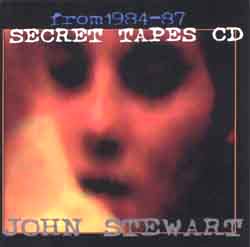 (The
image is from the cover of the CD re-issue)
(The
image is from the cover of the CD re-issue)
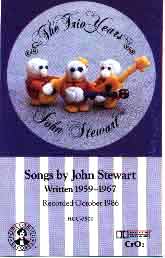 The
Trio Years
The
Trio Years
1986 Homecoming Records release on cassette
Produced by John Stewart
(Cover image is from the Homecoming Cassette release)
Take the songs that John Stewart wrote (alone or with John Phillips in one case) while with the Kingston Trio twenty years before and more. Rethink them, rearrange them, and push them through the combined talents of John Hoke on keyboard, Dave Batti on bass, Dennis Kenmore on percussion, and John Stewart himself on guitars, percussion and synthesizers. Bring in Nick Reynolds to sing, along with everybody else.Turn it way, way up. This is another outbreak of our friend's full-throttle, "yin" folk music— done with impeccable style, instrumental precision, textured vocals—and with hampers full of joy and humor.
You don't have to set your watch back twenty years. You won't even want to. This is so crisp, so clean, and so perfect that when it gets sprung on unprepared listeners, the response is usually, "Why isn't music hopeful like that anymore?"
Actually, it can be. Here it is...
The songs:
Side One
1. Hit and Run
2. Those Who Are Wise
3. Road to Freedom
4. Run the Ridges
5. The New Frontier 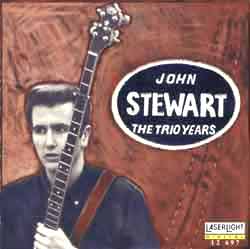
(The image is from the cover of the Laserlight CD re-issue)
Side Two
6. One More Town
7. Lock All the Windows
8. Green Grasses
9. Chilly Winds
10. Children of the Morning
 The original
cassette of The Trio
Years is out-of-print.
It was re-issued in CD format and the Laserlight CD is also out of print.
The original
cassette of The Trio
Years is out-of-print.
It was re-issued in CD format and the Laserlight CD is also out of print.
 One
Night in Denver
One
Night in Denver
Johnny Dreams and the Technicolor Yawn
1998 Homecoming Records release on CD
Produced by John Stewart
(Cover image is from the CD)
Cover sketch by John Stewart)
This is another instance where the album appears in the order of its performance (February 21st, 1987 at the Fairmont Hotel), rather than of its issue. As Tom De Lisle, the premier writer on all things Stewart has said, " 'Denver' is John Stewart at his live-show best. It is sobering to consider that a man whose...hard-core fans consider the best singer-songwriter of his time is ALSO among the most riveting and entertaining live performers of the American Century. The proof of that is here on 'Denver'—the songs, the energy, the casual wit honed in John's Kingston Trio days of 1961-'67. Keep in mind in listening to the power of his work here that this show was NOT taped for release; it was only recorded routinely off the house sound system onto a cassette by local engineer 'Checkers.'
The sound here is 'bigger' than the usual Stewart style, thanks to inspired backing by John Hoke on the synthesizer, 'Dave' Batti, John's longtime sidekick and bassist, drummer Dennis Kenmore, and searing saxophone contributions on 'Gold' and 'Midnight Wind' by Fairmont house bandmember Brian Haymer..."
It is one heck of a show.
But don't forget that it is not, and evidently never was, audibly perfect. You are going to have to fuss with the equalization a little to get it to your ear and taste, and put up with a little echo. If you aren't willing to do those things, skip ahead to Neon Beach. If you already have Neon Beach, this will give you a privileged window into the building of the engine that Stewart and his friends were by then fine-tuning in studios and living rooms and live performances like this one.
And when John Stewart drops the BIG engine into his music...Oh, Lordie...
The songs:
1. Ticket to the Stars
2. Daydream Believer
3. New Frontier Intro
4. The New Frontier
5. Always Young Intro
6. Always Young
7. July You're a Woman
8. Botswana
9. Midnight Intro
10. Midnight of the World
11. Pirates of Stone County Road
12. Midnight Wind
13. Gold Intro
14. Gold
15. Mother Country
16. Solsbury Hil
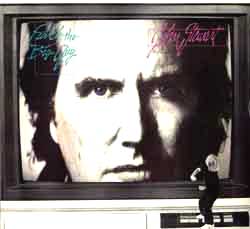 Punch
the Big Guy
Punch
the Big Guy
1987 Cypress Records release on
LP
Produced by John Stewart
(Cover image is from the LP)
A poet looks toward fifty...Of all the many long letters from this astounding friend, this is very arguably the most precious. For those who had been relying on "major label" record bins as the John Stewart General Delivery Box, it had been as much as five years since the last one. Between life, laundry and late children, the time had certainly been full, but we had been missing him...
And then one day this gentle rocket sailed in over the transom. Seldom have we ever been so complimented by an album. John Stewart chose not to sing at us, as so many had been doing. And he didn't really sing to us, either. That would assume two separate sides to the transaction. This was a sharing, a love letter to the best in us. It came right out and explicitly said, "I'm worried about you and I'm worried about me..." Some of us would never quite be able to turn "Runaway Train" into a song to just one person, although it was clearly a love song.
These were densely textured paragraphs, written by a fire...carefully paced passages for questioning and concern, wonderment and trust in the truth of hearts—the unspoken and seldom recognized American collective mind and soul, with all its imperfections and dreams of redemption.
This album is timeless. If you have never heard it and play it today, kind readers, it will still be as vital and topical and challenging and comforting as the day it was originally delivered. And, above all, respectful of us all...
This album is seamless. The stream of caring, words and notes flows smoothly through thoughtful changes in tempo and dynamic that allow us to fill chapters from our own lives and thoughts into this open novel, and walk the threads of irony and faith he has used to bridge between aloneness and community.
The previous summer, Lady Liberty had turned a hundred. Now the tall ships were gone, but John Stewart seemed to still be hearing the wind in the rigging of our collective thoughts: "...there are strange rivers who know our destiny...and we're sailors, you and me..."
If you read the morning papers and have never heard this masterpiece, there has been a long and caring letter from a friend out there by your doorstep for quite a while now. This might be a very good time to look under the leaves for it...
At the very least, you will have an eloquent and thoughtful companion when you start moving mental furniture and dusting the blinds of another day. And when you really need to hear "If something happened to you, part of me would die. If something good came through, part of me would fly..." this priceless and very human being will be waiting...
The songs:
Side One
1. Angels With Guns
2. Strange Rivers
3. Hunters of the Sun
4. Price of the Fire
5. Midnight of the World
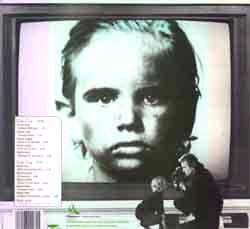 (Image
is from the back of the original album)
(Image
is from the back of the original album)
Side Two
6. Night of a Distant Star
7. Botswana
8. Ticket to the Stars
9. Runaway Train
10. Children of the New Frontier
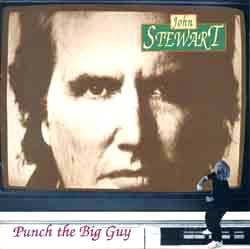
(The image is from the cover of the CD re-issue)
The original issue of Punch the Big Guy is out-of-print. The first two CD reissues are also out of print. In 2008, Neon Dreams reissued this landmark album, and this third reissue is now also out-of-print.
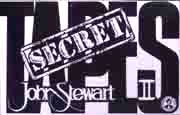
The
Secret Tapes II
1987-8 Homecoming Records release on cassette
Produced by John Stewart
(Cover image is from the cassette sleeve)
Pound-for-pound, peeled and boiled down, this is the most album for the money most of us will ever hear. It is the cleanest, quickest, leanest and most essential package that even John Stewart has ever delivered, and that is saying a ton, considering the absolute classics he has produced. We have no strong opinions about it, of course...It was a cassette-only release in two versions (the UK issue had three additional songs). Unless you went to his concerts or haunted the Schwann catalogue you didn't know about it. Even after it was "cleaned up" and reissued as the second disk on a 2-CD set in 2002, it has somehow managed to escape the attention it has deserved. Unbelievable...
A friend has described this as "feng shui folk music." When asked what that meant, she said, "Everything is exactly where it should be, and there is nothing extra." Wish we'd said that...
About half of these songs would go on to become highlights on the classic live and studio albums that were about to erupt from the creative genius of John Stewart, but this is the only place you can get some equally vital songs, like "Call the Women Home" and "I Could Have Been a Runner." And this is the place where you can get them stripped for speed, tooled for the street, and already, incredibly, complete and mature.
When one considers that this collection came on the heels of Punch the Big Guy, which closely followed The Secret Tapes '86, all you can really do is shake your head. Stack 'em up in your changer and play the output of this artist in just three years. Even as you listen to this outpouring of wisdom and whimsy and compassion and care, you will find yourself saying, "Nobody can do that!"
Nobody but the plainspoken poet, anyway.
This is the second argument for why the 2-CD reissue of The Secret Tapes is an absolutely necessary part of any John Stewart collection. The first argument was Secret Tapes '86. Enough said.
The songs:
Side One
1. Grace of Rain
2. Seven Angels
3. Irresistible Targets
4. Quarter Moon on the Golden Gate
5. The Heartless
Side Two
6. I Could Have Been a Runner
7. Call the Women Home
8. Sweet Dreams
9. Women
10. Tears of the Sun
 (The
image is from the cover of the CD re-issue)
(The
image is from the cover of the CD re-issue)
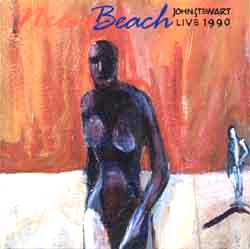 Neon
Beach—John Stewart Live
Neon
Beach—John Stewart Live
1990 Line Records release on CD
Produced by John Stewart
(Cover image is from the CD cover insert)
PFM... It's an old military acronym. It's how bumblebees fly. And helicopters. After all, you can look at them and see that they'll never get off the ground, right? The thing is, nobody told the bee he was aeronautically untenable. And everybody knows that fling-wing pilots are nuts, so that's the explanation for that one. In the hands of a sane pilot, a helicopter would clearly screw itself into the ground. The "M" is for "magic."That's applied PFM. There's also free-floating PFM. That's more like karma, or the "zone" that some athletes and pool shooters can get into. There was an interview with Johnny Unitas a number of years ago, and he was asked how he could throw a football on a flat trajectory through a crowd of rapidly moving linemen and backs much taller than he was. Reportedly, he looked puzzled and said something like, "I just throw it where they aren't going to be." Think about that. He has to have been looking at things in slow motion—a couple of seconds in the future!
Free-floating PFM is like Saint Elmo's Fire. It accumulates and takes on its own ethereal substance, in the presence of just the right corporealities here in the "real" world. Like masts and spars and airplane wings. Or, maybe, guitars and keyboards and drum kits, sometimes.
If all of that is a little too "airy-fairy" for you, kind reader, track down a video called "The Lightning Hunters" (if we remember the title correctly). It's really about scientists trying to attract lightning so it can be studied and viewed. How do you pull lightning out of the sky, ok? Hidden in the last part of this already fascinating little piece is some video of the electro-magnetic storms that surround the Earth—all the time. That's right—you can see them from space! There is a glowing, pulsing, shifting, spiking, continuous swirling mountainous aura around us that is visible to the human eye. There's a quiet theory buried in there somewhere that we have evolved as beings sensitive to magnetism and electricity. Sounds boring and insignificant, right? Take our words for it—five seconds of seeing what's been out there, forever, will change the way you look at the world, forever. Those pictures will never leave your head. We promise...
Sometimes PFM can also be visible to the human ear.
In Brother Stewart's own words: "It was a strange night to record. We were there to record Bill Lynch, one of LA's top blues men. Since the machine would be set up and ready to go, we decided: 'What the heck let's record our set as well'. We, we being Dave Batti and myself, called in the troops. My son Mikael to record and help produce, Dennis Kenmore on drums and Chris Mostert on sax. Bill said he'd play electric guitar and Dave of course was our only choice for bass. I had a few songs yet to be recorded... We opened with...one of my favorite Tim Hardin tunes... that we had never played live.
...Dave was well acquainted with the tunes. Everyone else was just feeling their way along... I was coming down with a bad throat (and) lost my voice several times during the show... Neon Beach didn't have a chance to get self-conscious. We just went in and did it..."
Magic happens. You can call down the lightning if you don't worry about calling down the lightning, evidently. Just don't tell those scientists. Maybe it only works for musicians? Nope! We don't think so around here.
This album is incredible! It is a payoff for ten years of this magnificent artist paying untold dues, building and rebuilding his craft, staying out of the ditches on the slippery roads that creators of lasting art always travel, and investing himself in honest love and sharing with people whose names he didn't know. It's like he won the Powerball...and then gave it to friends he'd never met.
Somehow, in a crowded bar full of noisy drunks, on a September night three days after his birthday, he and Dave Batti and and Chris Mostert and Dennis Kenmore and Bill Lynch called the lightning down out of that aura around the earth and caught it in their hands.
This thing is way past synergistic.
This thing is PFM...
The songs:
1. Lady Came from Baltimore
2. Dreamers on the Rise
3. Angels With Guns
4. Looking for Jack
5. Shake, Rattle and Roll
6. Strange Alliance
7. Seven Angels
8. Grace of Rain
9. Bad Rats
10. Hunters of the Sun
11. Gold Medley
Neon Beach—John Stewart Live 1990 was originally issued as a Homecoming Records cassette and is out of print. The Line Records CD of this recording is now also out of print, as is the Neon Dreams reissue of this keystone live album.
Click here to continue with the albums between 1990 and 1996.